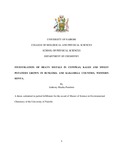| dc.description.abstract | This study investigates the level of heavy metals in selected food crops grown in Bungoma and Kakamega counties, Western Kenya. Copper (Cu), Lead (Pb), Cadmium (Cd), Chromium (Cr) and Zinc (Zn) were determined in cowpeas, kales, sweet potatoes and the soils which they grew on during the months of November 2010 (wet season) and February 2011 (dry season). A total of 25 sites were investigated. An Atomic Absorption Spectrophotometer was used for analysis of the samples after wet digestion and preparation of appropriate calibration standards. Lead in eleven percent of soil samples exceeded the range for unpolluted soils of 0.1 to 20 ppm. All cowpeas and kales samples had lead levels exceeding the recommended limit of 0.3 ppm while 95% of sweet potatoes samples exceeded the safe limit. Copper in soil samples was within the recommended limit of 100 ppm. Sweet potatoes and kales had copper concentrations within the recommended limit of 10 ppm, while 40 % of the cowpeas samples exceeded the safe limit. Zinc in soils, cowpeas, kales and sweet potatoes was within the range of background values for unpolluted environment. Chromium and cadmium were not detected in cowpeas, sweet potatoes and kales. There was positive correlation (p>5) between the wet and dry seasons, indicating insignificant seasonal variations in heavy metal concentrations | en_US |

